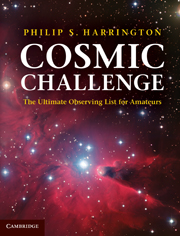Book contents
- Frontmatter
- Contents
- Preface
- Acknowledgments
- Photo credits
- 1 Meeting the challenge
- 2 Naked-eye challenges
- 3 Binocular challenges
- 4 Small-scope challenges: Giant binoculars, 3- to 5-inch telescopes
- 5 Medium-scope challenges: 6- to 9.25-inch telescopes
- 6 Large-scope challenges: 10- to 14-inch telescopes
- 7 Monster-scope challenges: 15-inch and larger telescopes
- Epilogue: The edge of imagination
- Appendix A The cosmic challenge
- Appendix B Suggested further reading
- Appendix C 100 challenging double stars
- Index
Epilogue: The edge of imagination
Published online by Cambridge University Press: 06 December 2010
- Frontmatter
- Contents
- Preface
- Acknowledgments
- Photo credits
- 1 Meeting the challenge
- 2 Naked-eye challenges
- 3 Binocular challenges
- 4 Small-scope challenges: Giant binoculars, 3- to 5-inch telescopes
- 5 Medium-scope challenges: 6- to 9.25-inch telescopes
- 6 Large-scope challenges: 10- to 14-inch telescopes
- 7 Monster-scope challenges: 15-inch and larger telescopes
- Epilogue: The edge of imagination
- Appendix A The cosmic challenge
- Appendix B Suggested further reading
- Appendix C 100 challenging double stars
- Index
Summary
Trying to draw up a finite list of challenging objects scattered through the infinite universe is an almost insurmountable task. That became all too apparent as this book evolved. In fact, when I wrote the “Challenge Object” column in Deep Sky magazine back the 1980s, targets that I thought were difficult tests back then have subsequently proven to become old friends that I visit often. Others, however, proved to be so difficult back then that they jumped up an aperture class, if they are included in this book.
It would be a very easy task to assemble a volume 2 to this book simply from the leftovers that I chose not to include here for one reason or another. Indeed, the Cosmic Challenge could become a multi-volume set. But, rather than do that, I leave the task of developing volume 2 to you, the reader.
As you explore the objects discussed here, you will undoubtedly bump into other targets that are just as challenging, and perhaps even more so. Prompted by those, began to compile your own favorite list of cosmic challenges.
Perhaps your challenges favor Solar System targets. If so, begin with the Lunar 100 list of targets. Created by Charles Wood and first appearing in the April 2004 issue of Sky & Telescope magazine, the Lunar 100 offers, in Wood's own words, “a selection of the Moon's 100 most interesting regions, craters, basins, mountains, rilles, and domes; to provide Moon lovers with something akin to what deep-sky observers enjoy with the Messier catalog.
- Type
- Chapter
- Information
- Cosmic ChallengeThe Ultimate Observing List for Amateurs, pp. 448 - 449Publisher: Cambridge University PressPrint publication year: 2010

